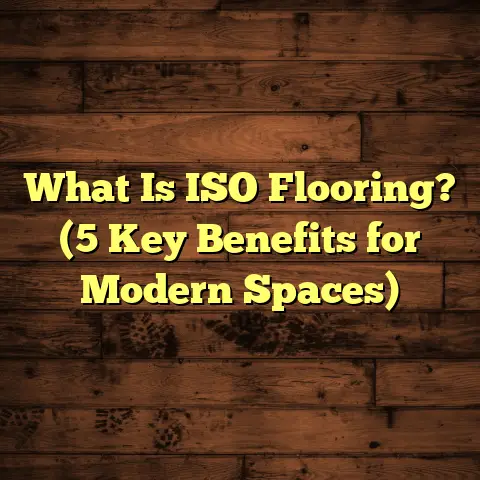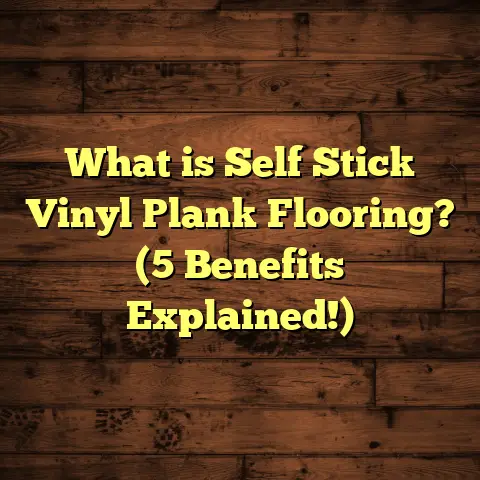What is African Mahogany Hardwood Flooring? (5 Reasons to Choose)
I’ve always believed that the floors beneath us are more than just a surface. They carry the weight of our daily lives, reflect our tastes, and sometimes connect us to places far beyond our homes. When I started working in flooring, I quickly learned that picking the right wood isn’t just about looks. It’s about how the material performs, how it ages, and what kind of story it tells. That’s why African Mahogany hardwood flooring caught my attention. It stands out in ways many hardwoods don’t—both in appearance and performance. If you’re thinking about upgrading your floors or just curious about this exotic yet accessible option, I’m happy to share everything I’ve learned through years of hands-on experience and research.
What is African Mahogany Hardwood Flooring?
Let’s start with the basics. African Mahogany hardwood flooring is made from trees belonging to the Khaya genus, primarily found in West and Central Africa. This wood is often confused with American or Brazilian mahogany, but it’s actually quite different botanically and materially. The Khaya species include Khaya ivorensis, Khaya anthotheca, Khaya senegalensis, and a few others. These trees grow tall and straight in tropical forests, producing durable timber prized worldwide.
The wood itself has a warm reddish-brown color that deepens to a rich chocolate hue over time. Its grain varies from straight to interlocked with a medium texture, giving floors a unique character that many homeowners fall in love with. African Mahogany is classified as a hardwood due to its dense fiber structure and ability to withstand wear.
One key thing I’ve noticed is how versatile this wood is. It’s used not only for flooring but also for furniture, cabinetry, musical instruments, and even boat building. That speaks volumes about its strength and beauty.
The harvesting of African Mahogany today often comes with sustainability certifications like FSC (Forest Stewardship Council), which means the wood is sourced responsibly—an important factor for many modern homeowners who want their choices to be eco-friendly.
Why African Mahogany? Five Reasons I Choose It for Flooring Projects
I’ve installed countless types of hardwood floors over my career, but African Mahogany remains one of my favorites. Here are five reasons why I often recommend it:
1. Proven Durability That Holds Up in Real Life
Durability is non-negotiable when it comes to flooring. No one wants a floor that dents and scratches after just a few months of use.
African Mahogany scores between 1,150 and 1,260 on the Janka hardness scale. For context, the Janka test measures how much force it takes to embed a steel ball halfway into a wood sample — essentially showing how resistant it is to dents.
To give you a clearer picture:
- Red Oak (common in the US) scores around 1,290
- Hard Maple scores 1,450
- Brazilian Cherry (Jatoba) scores 2,350
- African Mahogany sits comfortably in the mid-range
This means African Mahogany isn’t the absolute hardest wood out there, but it’s tough enough for most residential applications. In fact, I’ve seen it perform remarkably well in homes with kids and pets—two of the biggest challenges for any flooring.
In one project with active young children and two large dogs, the owners reported minimal denting or scratching after two years. The floor maintained its smooth finish and natural richness without needing early repairs or refinishing.
2. Aesthetic Versatility That Matches Many Styles
I tend to think of African Mahogany as the “chameleon” of hardwoods when it comes to design. The wood’s natural color ranges from light pinkish tones to deep reddish browns, often with subtle streaks or ribbon-like grain patterns.
This variability means each plank looks unique, adding depth and personality to the floor.
If you like cozy, warm interiors with earth tones or rustic elements, African Mahogany complements those beautifully. At the same time, its clean grain and rich color work well in contemporary or minimalist settings where you want a bit of natural warmth without overpowering sleek furniture.
I once helped a client who had an open-concept living room with modern furnishings but wanted a floor that added warmth without clashing with their metal and glass décor. African Mahogany struck the perfect balance—bringing organic richness without looking dated or overly traditional.
3. Stability That Works Across Climates
One problem hardwood floors encounter is movement caused by changes in humidity and temperature—warping, cupping, gaps between boards.
African Mahogany has shown good dimensional stability compared to many other hardwood species. Its density helps resist swelling and shrinking when moisture levels fluctuate.
In humid climates like the southeastern US or coastal areas where moisture in the air can vary day-to-day, this stability pays off by keeping floors looking tight and smooth year-round.
For example, I installed African Mahogany flooring in a beachside home where seasonal humidity swings were significant. The homeowner noticed very little change in floor gaps or warping compared to previous floors made of other woods.
4. Environmentally Responsible Sourcing
Sustainability has become a huge concern for many homeowners I talk to. The last thing anyone wants is to contribute to deforestation or habitat destruction.
Fortunately, a large portion of African Mahogany lumber comes from sustainably managed forests certified by FSC or similar organizations.
FSC-certified wood means harvesters follow strict guidelines protecting biodiversity, soil quality, and indigenous communities’ rights. These certifications also require replanting trees to ensure forest regeneration.
I always ask my suppliers for certification proof because it adds peace of mind that the beautiful wood in your home hasn’t come at an environmental cost.
5. Long-Term Value—Quality That Pays Off
Quality hardwood floors are an investment. Though African Mahogany can have a higher upfront material cost than domestic woods like oak or maple ($7–$12 per square foot on average), its durability means fewer repairs or replacements over decades.
Labor typically adds $3–$6 per square foot depending on installation complexity and location.
When budgeting these projects, I’ve found tools like FloorTally incredibly useful. They help me calculate accurate cost estimates factoring materials, labor rates in my area, waste percentages for cuts and errors—all consolidated into one clear report.
This prevents surprises during installation and helps my clients make well-informed decisions based on their budget constraints.
Over time, the value you gain from having a long-lasting floor that looks amazing far outweighs cheaper alternatives needing replacement every few years.
Inside My Work: Installing African Mahogany Floors
I want to share some personal insights from my experience installing African Mahogany hardwood floors on various projects to give you a better feel for what’s involved.
First off, working with this wood is generally straightforward for professionals but requires respect for its density and grain characteristics.
The planks sand down smoothly without excessive effort but do demand sharp blades since the wood fibers are dense.
On one job, we did engineered plank installation over radiant heat flooring—a tricky setup because moisture content must be controlled carefully. African Mahogany adapted well because of its inherent stability.
Cutting the boards showed beautiful grain patterns each time—no two pieces were identical—which challenged me to lay them out carefully for visual flow across rooms.
The finish applied was a high-quality water-based polyurethane that enhanced the reddish hues while protecting against everyday wear.
Months after installation, the homeowners emailed me pictures showing how sunlight through their windows transformed the floor’s color throughout the day—something I always enjoy seeing because it proves natural wood truly lives and breathes in a home environment.
What You Need to Know About Maintenance
No matter which hardwood you choose, maintenance affects how long your floors stay beautiful.
African Mahogany floors require similar care as other hardwoods: regular sweeping or vacuuming to remove dirt and grit that can scratch the finish; damp mopping with recommended cleaners; avoiding excessive water exposure; and refinishing every 7–10 years depending on wear patterns.
Avoid harsh chemicals or abrasive cleaners that break down protective coatings prematurely.
In my experience managing floor longevity across dozens of homes, those who stick to simple maintenance routines enjoy floors lasting 30+ years without major issues.
What Installation Challenges Should You Expect?
I often get asked if African Mahogany is difficult to install. For pros like myself, no. But for DIYers without specialized tools or experience?
It can pose challenges due to its density—cutting requires sharp blades—and its interlocked grain sometimes causes boards to splinter if handled roughly.
Pre-acclimation is key: letting planks sit in your home environment for at least 48 hours before installation helps prevent shrinkage or expansion afterward.
Also, choosing between solid versus engineered planks matters:
- Solid Hardwood: thicker boards sandable multiple times but less resistant to moisture.
- Engineered Hardwood: plywood base with thin mahogany veneer; better stability over radiant heat or moist areas but limited refinishing potential.
Hiring an experienced installer reduces risk of mistakes that can lead to costly fixes later.
Comparing African Mahogany Hardwood With Other Popular Woods
It helps to see how African Mahogany stacks up against common alternatives:
| Wood Type | Janka Hardness | Typical Price/Sq Ft | Color Range | Stability | Common Uses |
|---|---|---|---|---|---|
| African Mahogany | 1,150–1,260 | $7–$12 | Pinkish red to brown | Good | Flooring, furniture |
| Red Oak | 1,290 | $3–$7 | Light tan | Moderate | Flooring, cabinets |
| Hard Maple | 1,450 | $6–$10 | Creamy white | Moderate | Flooring, butcher blocks |
| Brazilian Cherry | 2,350 | $8–$15 | Deep reddish brown | Lower (color change) | Flooring |
| Teak | 1,070 | $10–$20 | Golden brown | Excellent | Outdoor decking & flooring |
African Mahogany offers a nice balance of durability and style at a mid-range price point with better stability than some heavier exotic woods prone to color changes or warping.
Real-Life Case Study: Coastal Home Renovation
Here’s a detailed case study from one project I worked on recently:
The client wanted hardwood floors that could handle oceanfront humidity without excessive warping or maintenance hassles. They also wanted warmth and elegance for their beach cottage style décor.
After discussing options like teak and Brazilian cherry, we settled on African Mahogany due to its stability and beautiful grain.
We installed engineered planks over a moisture barrier subfloor system. The process took about four days including acclimation time.
Two years later during follow-up visits, the homeowner reported zero issues with gaps or warping despite seasonal humidity spikes up to 85%.
They also loved how the floors deepened in color naturally without fading under intense sunlight exposure through large windows.
This project reinforced my belief that African Mahogany fits well in challenging environments while providing aesthetic benefits few woods can match at this price point.
Final Thoughts on Choosing Flooring That Fits Your Life
I always tell friends and clients that your choice of flooring should reflect not only your style but also your daily life needs—whether that means durability for an active household or stability for high-humidity areas.
African Mahogany hardwood flooring offers a combination of beauty, strength, eco-conscious sourcing, and long-term value that makes it worth serious consideration if you want something different yet reliable.
I hope sharing these insights helps you make an informed decision about your next flooring project. If you have questions about installation techniques or want advice on maintaining your floors long-term, I’m here to help anytime.
Have you walked across an African Mahogany floor? What stood out most? Feel free to share your experiences—I’d love to hear what stories your floors tell!





